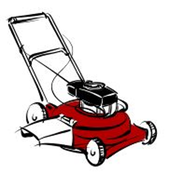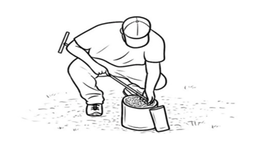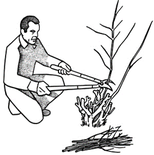January/February Planting Guide
Vegetables: artichoke (crowns), Asian greens, asparagus (1-2 yr. old crowns), beets, broccoli (T), cabbage (T), carrots, cauliflower (T), Swiss chard (S/T), collards (S/T), Fava beans, cool season greens, kale (S/T), kohlrabi (S/T), leeks (T), lettuce (S/T), mustard (S/T), onion (T), English & snow peas, Irish potato (certified disease free), radish, spinach (S/T) and turnip. (T = transplants S = seeds)
Flowers from Seed: ageratum, alyssum, calendula, coreopsis, cornflower, delphinium, Echinacea, feverfew, gaillardia, hollyhock, larkspur, nasturtium, drummondii phlox, poppy, queen anne’s lace, petunia, snapdragon, sweet peas and sweet William, just to name a few. In addition to these in February: cosmos, nicotiana, four o’clocks, marigold, stock, and verbena. Note - check your local nursery for seasonal flowering transplants.
Herbs: onion & garlic chives, parsley. In February add: dill, fennel, lemon balm, mint, rosemary and summer savory.
Note – grow horseradish in a deep container to keep roots from escaping; even a little bit of root will grow a new plant and become invasive.
Garden Bulbs: allium, canna crinum, daylily, gladiolus, hyacinth, spider lily, rain lily society garlic. In February add: agapanthus, amaryllis, and amarcrinum.
Flowers from Seed: ageratum, alyssum, calendula, coreopsis, cornflower, delphinium, Echinacea, feverfew, gaillardia, hollyhock, larkspur, nasturtium, drummondii phlox, poppy, queen anne’s lace, petunia, snapdragon, sweet peas and sweet William, just to name a few. In addition to these in February: cosmos, nicotiana, four o’clocks, marigold, stock, and verbena. Note - check your local nursery for seasonal flowering transplants.
Herbs: onion & garlic chives, parsley. In February add: dill, fennel, lemon balm, mint, rosemary and summer savory.
Note – grow horseradish in a deep container to keep roots from escaping; even a little bit of root will grow a new plant and become invasive.
Garden Bulbs: allium, canna crinum, daylily, gladiolus, hyacinth, spider lily, rain lily society garlic. In February add: agapanthus, amaryllis, and amarcrinum.
January/February Garden Maintenance Activities
Time for lawn equipment and gardening hand tool maintenance. Clean mower under-carriage of debris, sharpen or replace mower blades, filters and oil. Battery or electric operated mowers also need maintenance checks, refer to owner’s manual for tips. Examine tool handles for cracks, weak points and loose connections; remove rust and sharpen blade edges at the proper angle. Clean hand pruner blades, sharpen cutting edges to ensure a clean cut. There are many helpful YouTube videos for reference. Please don’t forget to protect yourself when using any equipment – gloves, eye and hearing protection, feet and leg protectors, whatever is suggested to keep you from accidental harm.
For safe use of lawn equipment see:
http://agsafety.tamu.edu/files/2011/06/LAWN-MAINTENANCE-SAFETY3.pdf
If you have a lawn irrigation system you should audit it. Measure the output of watering cycles and sprinkler heads then adjust the timing or replace heads as required to keep your lawn grass alive during drought periods. Wetting the soil to a depth of 6” is desired; watering infrequently, “as needed”, will encourage roots to go deep rather than stay near the soil surface. Landscape trees and shrubs with larger root systems need deeper watering at 8”-10” for root survival so soaker hoses are a better option for watering them. (Tip: Drip irrigation is a water saving improvement in landscape beds and vegetable gardens.)
https://wateruniversity.tamu.edu/irrigation/catch-can-test/
Gonzales County is in a severe drought which means homeowners need to water landscape plants, especially newly planted trees, shrubs. Provide 1” of water every 2 weeks to St. Augustine lawns to keep grass alive (it doesn’t go dormant), more often if on thin soils less than 6” in depth.
For safe use of lawn equipment see:
http://agsafety.tamu.edu/files/2011/06/LAWN-MAINTENANCE-SAFETY3.pdf
If you have a lawn irrigation system you should audit it. Measure the output of watering cycles and sprinkler heads then adjust the timing or replace heads as required to keep your lawn grass alive during drought periods. Wetting the soil to a depth of 6” is desired; watering infrequently, “as needed”, will encourage roots to go deep rather than stay near the soil surface. Landscape trees and shrubs with larger root systems need deeper watering at 8”-10” for root survival so soaker hoses are a better option for watering them. (Tip: Drip irrigation is a water saving improvement in landscape beds and vegetable gardens.)
https://wateruniversity.tamu.edu/irrigation/catch-can-test/
Gonzales County is in a severe drought which means homeowners need to water landscape plants, especially newly planted trees, shrubs. Provide 1” of water every 2 weeks to St. Augustine lawns to keep grass alive (it doesn’t go dormant), more often if on thin soils less than 6” in depth.
Test your soil at least every 3 years and do keep the results for comparison. A soil test report tells the gardener the pH, salinity, major nutrients such as (N) Nitrogen, (P) Phosphorus and (K) Potassium and the levels of micronutrients required for plant growth. Various test can be ordered, for the home gardener test #3 should provide the information you’ll need to decide which fertilizer to use. You can stop by the Gonzales County Extension Office (see page 4) for a soil test bag or use a freezer quart size bag for your sample. For instructions, to print the test form and mailing directions see: http://soiltesting.tamu.edu/files/urbansoil.pdf
Compost: Finished compost that is broken down doesn’t smell stinky or vinegary is a good amendment to veggie beds ahead of spring planting. Lawn grass also benefits from a light ¼”to ½” top dressing of compost and a generous top dressing around perennial beds will help kick-start spring growth when soil begins to warm up.
Compost: Finished compost that is broken down doesn’t smell stinky or vinegary is a good amendment to veggie beds ahead of spring planting. Lawn grass also benefits from a light ¼”to ½” top dressing of compost and a generous top dressing around perennial beds will help kick-start spring growth when soil begins to warm up.
Pruning of most perennials and evergreens is delayed until just before spring growth begins or after spring bloom if buds form on previous season’s growth. Removing dead branches can be done anytime however removing live material encourages tender new growth subject to injury during a cold snap. Consult references for recommendations in our area for each species of plant in your landscape, such as roses (mid-February), firebush, canna, rosemary, plumbago, etc. For more general information on pruning landscape trees and plants see:
https://aggie-horticulture.tamu.edu/earthkind/landscape/proper-pruning-techniques/
https://aggie-horticulture.tamu.edu/earthkind/landscape/proper-pruning-techniques/


